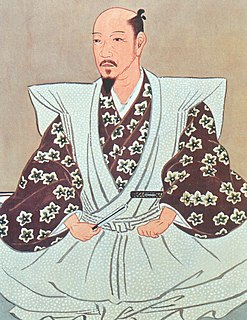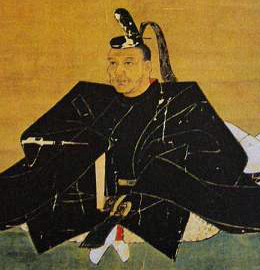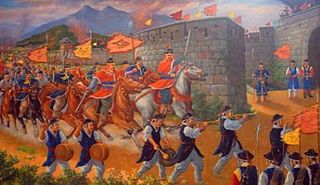 W
WAn Bangjun was one of the Neo-Confucian scholars, politicians and writers of the Korean Joseon Dynasty and he was a Righteous army(Uibyong) leader during the Japanese invasions of Korea.
 W
WAnkokuji Ekei was a descendant of the Takeda clan of Aki province. Although it is certain that he was from the Aki Takeda clan, there are various theories about his birth year and father, and the former is said to have been in 1537 or 1539.
 W
WBak Jin, also known as Park Jin, was a Korean Joseon Dynasty Army general and politician. He was one of the Korean generals of the Imjin War.
 W
WGwon Yul was a Korean Army General and the Commander-in-chief of the Joseon Dynasty, who successfully led the Korean forces against Japan during the Japanese invasions of Korea (임진왜란). He is best known for the Battle of Haengju where he defeated an attacking force of about 30,000 Japanese with 2,800 troops.
 W
WHeo Jun was a Korean physician. He was the court physician of the Yangcheon Heo clan during the reign of King Seonjo of the Joseon Dynasty in Korea.
 W
WNavy captain Jeong Bal was a Joseon dynasty navy captain who commanded a garrison at Busan port.
 W
WKatō Kiyomasa was a Japanese daimyō of the Azuchi–Momoyama and Edo periods. His court title was Higo-no-kami. His child name was Yashamaru, and first name was Toranosuke. He was one of Hideyoshi's Seven Spears of Shizugatake.
 W
WKikkawa Hiroie was a Japanese daimyō of the Azuchi–Momoyama period through early Edo period. Hiroie's father was Kikkawa Motoharu and his mother was a daughter of Kumagai Nobunao.
 W
WKim Chung-seon (1571–1642), birth name Sayaka (沙也可) and often known by his pen name Mohadang, was a Japanese general who defected to Korea during the Japanese invasion.
 W
WKim Ung-so (1564–1624) was a senior military officer in the Joseon dynasty. During the Imjin war, he was in charge of soldiers and horses in the Eastern Gyeongsang Province.
 W
WKobayakawa Hideaki was the fifth son of Kinoshita Iesada and the nephew of Toyotomi Hideyoshi. He was gained the rank of Saemon no Kami (左衛門督) or in China Shikkingo (執金吾) at genpuku and held the court title of Chūnagon (中納言), Hideaki was also called Kingo Chūnagon (金吾中納言).
 W
WKobayakawa Takakage was a samurai and daimyō during the Sengoku period and Azuchi–Momoyama period. He was the third son of Mōri Motonari who was adopted by the Kobayakawa clan and became its 14th clan head. He merged the two branches of the Kobayakawa, the Takehara-Kobayakawa clan (竹原小早川氏) and Numata-Kobayakawa clan (沼田小早川氏). He became an active commander of the Mōri army and he with his brother Kikkawa Motoharu became known as the “Mōri Ryōkawa", or “Mōri's Two Rivers" (毛利両川). As head of the Kobayakawa clan, he expanded the clan's territory in the Chūgoku region, and fought for the Mōri clan in all their campaigns
 W
WKonishi Yukinaga was a Kirishitan daimyō under Toyotomi Hideyoshi. Konishi Yukinaga was the son of a wealthy Sakai merchant, Konishi Ryūsa. Ryūsa's wife was also baptised under the name of Magdalena.
 W
WKuroda Nagamasa was a daimyō during the late Azuchi–Momoyama and early Edo periods. He was the son of Kuroda Kanbei, Toyotomi Hideyoshi's chief strategist and adviser.
 W
WLi Rusong (1549–1598) was a Chinese general of the Ming dynasty who was from Tieling, Liaodong. He was the commander-in-chief of the Ming army in the first half of the Imjin War that took place in the Korean peninsula. Upon the request of the Korean King Seonjo of Joseon, the Ming Wanli Emperor sent reinforcements to support the Korean military in its war effort against the Japanese invasion masterminded by Toyotomi Hideyoshi. His father, Li Chengliang, who was also a Ming general, was known for defending Liaodong from the Jurchens. Based on historical documents, Li Rusong's 6th generation ancestor Li Ying (李英) was originally from Chosan in present-day North Korea, however there are historical documents which state that the further ancestors of the Li family were from central China who moved to Korea during wartime.
 W
WMa Gui (1543–1617) (simplified Chinese: 麻贵; traditional Chinese: 麻貴; pinyin: Má Guì; Wade–Giles: Ma2 Kui4) was the general of the armies of the Ming Dynasty between 1589 and 1610. A member of the Hui minority of China, he served the Han rulers with great loyalty. He participated in various campaigns against the Mongols in his career, and serving with great distinction, he led Ming force in the second Japanese Invasions of Korea his final position was the commander of Liaodong Peninsula.
 W
WMōri Hidemoto was a senior retainer of the Toyotomi clan throughout the latter Sengoku period of feudal Japan. Hidemoto was the eldest son of Mōri Motokiyo and initially began service under the Toyotomi as a military commander under his cousin Terumoto, the head of the Mōri clan.
 W
WMōri Terumoto was a Japanese daimyō. The son of Mōri Takamoto, and grandson and successor of the great warlord Mōri Motonari, he fought against Oda Nobunaga but was eventually overcome. He participated in Toyotomi Hideyoshi's Korean Campaign (1592) and built Hiroshima Castle, thus essentially founding Hiroshima.
 W
WNabeshima Naoshige was a warlord of the Sengoku and early Edo periods and progenitor of the Nabeshima lords of the Saga Domain. Naoshige was the second son of Nabeshima Kiyofusa , his mother the daughter of Ryūzōji Iesumi . He was a vassal of the Ryūzōji clan during the Sengoku period of the 16th century.
 W
WShimazu Tadatsune was a tozama daimyō of Satsuma, the first to hold it as a formal fief (han) under the Tokugawa shogunate, and the first Japanese to rule over the Ryūkyū Kingdom. As lord of Satsuma, he was among the most powerful lords in Japan at the time, and formally submitted to Tokugawa Ieyasu in 1602, to prove his loyalty, being rewarded as a result with the name Matsudaira Iehisa; Matsudaira being a branch family of the Tokugawa, and "Ie" of "Iehisa" being taken from "Ieyasu", this was a great honor. As of 1603, his holdings amounted to 605,000 koku.
 W
WShimazu Yoshihiro was the second son of Shimazu Takahisa and the younger brother of Shimazu Yoshihisa. Traditionally believed to be the 17th head of the Shimazu clan, he was a skilled general during the Sengoku period who greatly contributed to the unification of Kyūshū.
 W
WSō Yoshitoshi was a Sō clan daimyō of the domain of Tsushima on Tsushima Island at the end of Japan's Sengoku period, and into the Edo period. His name is sometimes read as Yoshitomo. Under the influence of Konishi Yukinaga, he was baptized and accepted the name "Dario". He took part in Toyotomi Hideyoshi's invasions of Korea in the 1590s, and led a force in the Siege of Busan.
 W
WSong Sang-hyeon was a civil minister, writer, and general during the Joseon dynasty. He was the prefect of Dongnae during the Siege of Dongnae, one of the first battles of the Imjin War. He led troops against Japanese general Konishi Yukinaga and was defeated. When presented with demands of surrender, Song famously declined and was captured alive and subsequently killed. His pen name was Cheongok, his courtesy name was Deokgu, and his posthumous name was Chungnyeol.
 W
WToyotomi Hideyoshi was a Japanese samurai and daimyo of the late Sengoku period regarded as the second "Great Unifier" of Japan.
 W
WYeonggyu was a Korean Buddhist monk and militia leader who fought in the Imjin war. He was killed in the third battle of Geumsan in 1592.
 W
WYi Bok-nam was a Korean naval commander and politician of the Joseon Dynasty. He passed the military examination and attained the position of Byeongmajeoldosa for Jeolla Province. He served against the Japanese navy during the Imjin war. His courtesy name was Subo.
 W
WAdmiral Yi Sun-sin was a Korean admiral and military general famed for his victories against the Japanese navy during the Imjin war in the Joseon Dynasty. Yi has since been celebrated as a national hero in Korea.